SKODA OCTAVIA 2009 2.G / (1Z) Owner's Manual
Manufacturer: SKODA, Model Year: 2009, Model line: OCTAVIA, Model: SKODA OCTAVIA 2009 2.G / (1Z)Pages: 304, PDF Size: 19.56 MB
Page 111 of 304
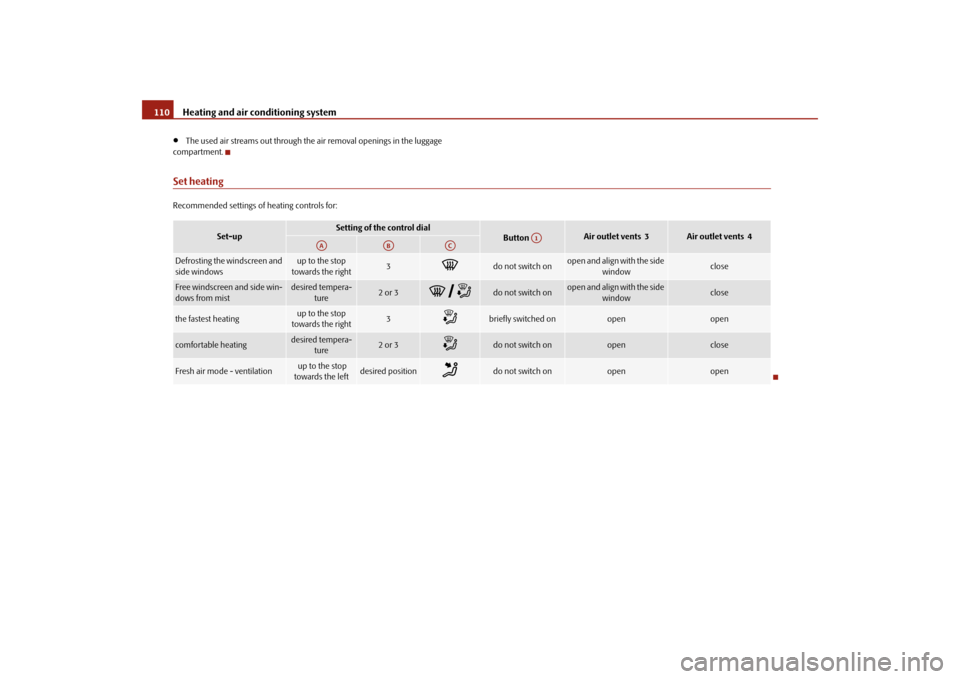
Heating and air conditioning system
110
•
The used air streams out through the air removal openings in the luggage
compartment.Set heatingRecommended settings of heating controls for:
Set-up
Setting of the control dial
Button
Air outlet vents 3
Air outlet vents 4
Defrosting the windscreen and side windows
up to the stop towards the right
3
do not switch on
open and align with the side
window
close
Free windscreen and side win- dows from mist
desired tempera-
ture
2 or 3
do not switch on
open and align with the side
window
close
the fastest heating
up to the stop towards the right
3
briefly switched on
open
open
comfortable heating
desired tempera-
ture
2 or 3
do not switch on
open
close
Fresh air mode - ventilation
up to the stop towards the left
desired position
do not switch on
open
open
A1
AA
AB
AC
se0.1.book Page 110 Frida
y, April 10, 2009 3:19 PM
Page 112 of 304
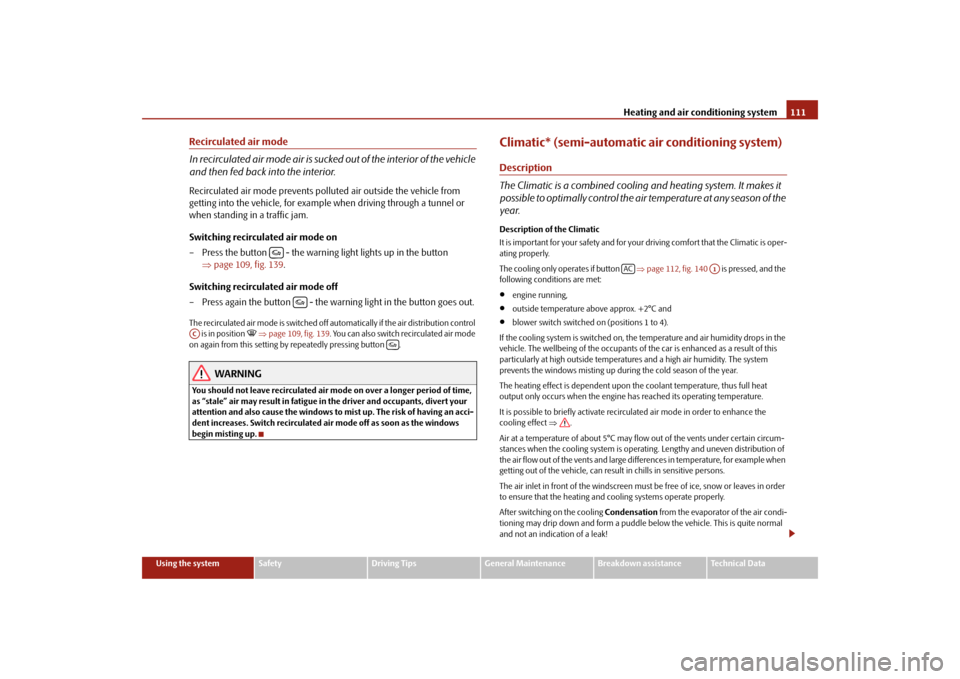
Heating and air conditioning system
111
Using the system
Safety
Driving Tips
General Maintenance
Breakdown assistance
Technical Data
Recirculated air mode In recirculated air mode air is sucked
out of the interior of the vehicle
and then fed back into the interior.Recirculated air mode prevents polluted air outside the vehicle from getting into the vehicle, for example when driving through a tunnel or when standing in a traffic jam. Switching recirculated air mode on – Press the button - the warning light lights up in the button
⇒
page 109, fig. 139
.
Switching recirculated air mode off – Press again the button - the warning light in the button goes out.The recirculated air mode is switched off au
tomatically if the air distribution control
is in position
⇒page 109, fig. 139
. You can also switch recirculated air mode
on again from this setting by repeatedly pressing button .
WARNING
You should not leave recirculated air mode on over a longer period of time, as “stale” air may result in fatigue in
the driver and occupants, divert your
attention and also cause the windows to mist up. The risk of having an acci- dent increases. Switch recirculated
air mode off as so
on as the windows
begin misting up.
Climatic* (semi-automatic air conditioning system)Description The Climatic is a combined cooling and heating system. It makes it possible to optimally control the air temperature at any season of the year.Description of the Climatic It is important for your safety and for your driving comfort that the Climatic is oper- ating properly. The cooling only operates if button
⇒page 112, fig. 140
is pressed, and the
following conditions are met:•
engine running,
•
outside temperature above approx. +2°C and
•
blower switch switched
on (positions 1 to 4).
If the cooling system is switched on, th
e temperature and air humidity drops in the
vehicle. The wellbeing of the occupants of
the car is enhanced as a result of this
particularly at high outside temperatur
es and a high air humidity. The system
prevents the windows misting up during the cold season of the year. The heating effect is dependent upon th
e coolant temperature, thus full heat
output only occurs when the engine has reached its operating temperature. It is possible to briefly activate recirc
ulated air mode in order to enhance the
cooling effect
⇒
.
Air at a temperature of about 5°C may flow
out of the vents under certain circum-
stances when the cooling system is operating. Lengthy and uneven distribution of the air flow out of the vents and large differences in temperature, for example when getting out of the vehicle, can resu
lt in chills in sensitive persons.
The air inlet in front of the windscreen must
be free of ice, snow or leaves in order
to ensure that the heating and cooling systems operate properly. After switching on the cooling
Condensation
from the evaporator of the air condi-
tioning may drip down and form a puddle be
low the vehicle. This is quite normal
and not an indication of a leak!
AC
AC
A1
se0.1.book Page 111 Frida
y, April 10, 2009 3:19 PM
Page 113 of 304

Heating and air conditioning system
112
WARNING
•
For your own safety and that of other road users, ensure that all the
windows are free of ice, snow and mistin
g. Please familiarize yourself about
how to correctly operate th
e heating and ventilation systems, how to demist
and defrost the windows, as well as with the cooling mode.•
You should not leave recirculated air mode on over a longer period of
time, as “stale” air may result in fatigue in the driver and occupants, divert your attention and also cause the windows to mist up. The risk of having an accident increases. Switch recirculated air mode off as soon as the windows begin misting up.
Note
•
We recommend that you do not smoke in the vehicle when the recirculating air
mode is operating since the smoke which is drawn at the evaporator from the inte- rior of the vehicle forms deposits in the
evaporator of the air
conditioning system.
This produces a permanent odour when the air conditioning system is operating which can only be eliminated through considerable effort and expense (replace- ment of compressor).
Using the systemFig. 140 Climatic: Control elementsSetting temperature – Turn the control dial
⇒
fig. 140
to the right in order to increase the
temperature.
– Turn the control dial to the left in order to increase the tempera-
ture.
Controlling blower – Turn the blower switch into one of
the positions, 1 to 4, in order to
switch the blower on.
– Turn the blower switch into positi
on 0 in order to switch the blower
off.
– Pressing button - causes
the recirculating air system
⇒
page 114 to be switched on.
Control for air distribution – You can adjust the direction of the air flow using the air distribution
control
⇒
page 108.
AAAAABAB
A4
AC
se0.1.book Page 112 Frida
y, April 10, 2009 3:19 PM
Page 114 of 304

Heating and air conditioning system
113
Using the system
Safety
Driving Tips
General Maintenance
Breakdown assistance
Technical Data
switching cooling on and off – Press the button
⇒
page 112, fig. 140
. The warning light lights
up in the button.
– When you again press the switch , the cooling system is switched
off. The warning light in the button goes out.
Rear window heater – Press button . Further information
⇒
page 67, “Rear window
heater”.
Auxiliary heating (auxiliary heating) – Press the button in order to directly switch on/off the auxiliary
heating (auxiliary heating and ventilation. Further information ⇒
page 119, “Auxiliary heating (auxil
iary heating and ventilation)*”.
The set temperature will be automatica
lly maintained other than when the
control dial is on the extreme
right or extreme left position:
•
Extreme right position - full heating,
•
Extreme left position - full cooling,
•
The blower should aways be on to prevent the windows from misting up.Note
•
The whole heat output will be needed
to unfrost the windscreen and side
windows. No warm air will be fed to the footwell. This can lead to restriction of the heating comfort.•
The used air streams out through the air removal openings in the luggage
compartment.•
If the cooling system has not been switched on for a lengthy period, odours may
be produced at the evaporator because of
deposits. Switch the cooling system on
at least once a month for approximately 5 mi
nutes at the highest blower stage - also
during the cold season of the year - in
order to remove such odours. Also open a
window for a short time.•
Please refer to the information regarding recirculated air mode
⇒page 114.
Set ClimaticRecommended settings of Climatic controls for the respective operating modes:
AC
A1
AC
A2A3
Set-up
Setting of the control dial
Button
Air outlet vents 3
Defrosting the windscreen and side windows
recommended
22°C
3
switched off
do not switch on
open and align with the side
window
Free windscreen and side win- dows from mist
desired tempera-
ture
2
switched on
do not switch on
open and align with the side
window
the fastest heating
recommended
22°C
2
switched off
briefly switched on
open
AA
AB
AC
A1
A4
se0.1.book Page 113 Frida
y, April 10, 2009 3:19 PM
Page 115 of 304

Heating and air conditioning system
114
Recirculated air mode In recirculated air mode air is sucked
out of the interior of the vehicle
and then fed back into the interior.Recirculated air mode prevents polluted air outside the vehicle from getting into the vehicle, for example when driving through a tunnel or when standing in a traffic jam. Switching recirculated air mode on – Press the button
⇒
page 112, fig. 140
the warning light lights
up in the button.
Switching recirculated air mode off – Press again the button - the warning light in the button goes out.The recirculated air mode is switched off au
tomatically if the air distribution control
is in position
⇒page 112, fig. 140
. You can also switch recirculated air mode
on again from this setting by
repeatedly pressing button .
WARNING
You should not leave recirculated air mode on over a longer period of time, as “stale” air may result in fatigue in the driver and occupants, divert your attention and also cause the windows to mist up. The risk of having an acci-dent increases. Switch recirculated air mode off as soon as the windows begin misting up.Using the air conditioning system economicallyThe compressor on the air co
nditioning system uses po
wer from the engine when
in cooling mode which will effect the fuel consumption. It recommended to open the windows or the doors of a vehicle for which the inte- rior has been strongly heated through the ef
fect of direct sunlight in order to allow
the heated air to escape. The cooling system should not be switched on while travelling when the window is open. The desired interior temperature can also be achieved without switching in the cooling system just by switching to fresh air mode.
comfortable heating
desired tempera-
ture
2 or 3
switched off
do not switch on
open
the fastest cooling
recommended
22°C
briefly 4, then
2or 3
switched on
briefly switched on
open
optimal cooling
desired tempera-
ture
1, 2 or 3
switched on
do not switch on
open and align to the roof
Fresh air mode - ventilation
up to the stop towards the left
desired position
switched off
do not switch on
open
Set-up
Setting of the control dial
Button
Air outlet vents 3
AA
AB
AC
A1
A4
A4
AC
se0.1.book Page 114 Frida
y, April 10, 2009 3:19 PM
Page 116 of 304
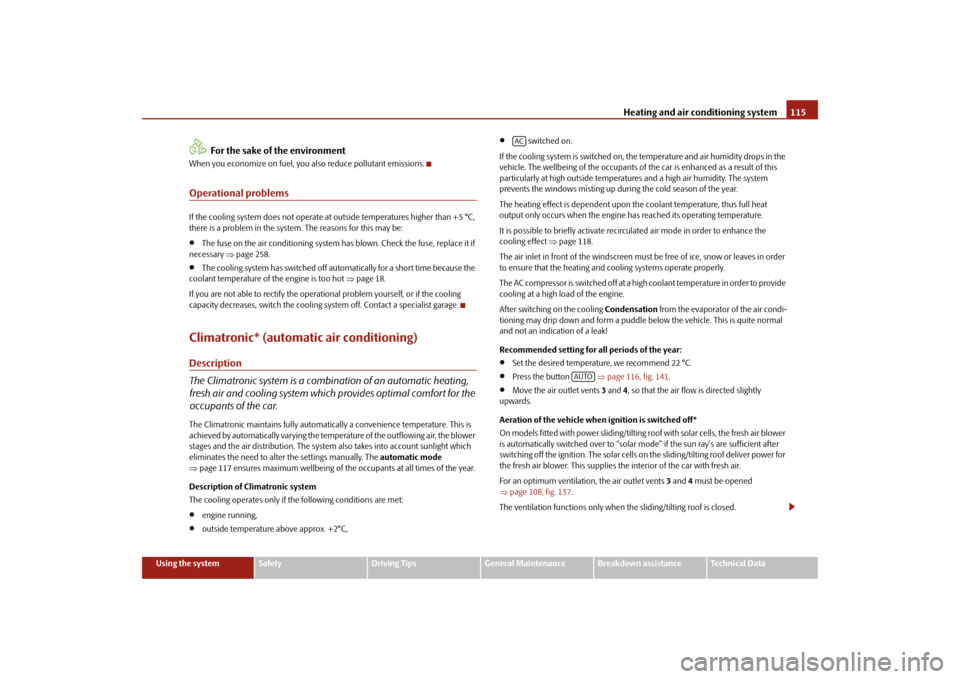
Heating and air conditioning system
115
Using the system
Safety
Driving Tips
General Maintenance
Breakdown assistance
Technical Data
For the sake of the environment
When you economize on fuel, you
also reduce pollutant emissions.
Operational problemsIf the cooling system does not operate at outside temperatures higher than +5 °C, there is a problem in the system. The reasons for this may be:•
The fuse on the air conditioning system
has blown. Check the fuse, replace it if
necessary
⇒page 258.
•
The cooling system has switched off automatically for a short time because the
coolant temperature of the engine is too hot
⇒page 18.
If you are not able to rectify the operat
ional problem yourself, or if the cooling
capacity decreases, switch the cooling sy
stem off. Contact a specialist garage.
Climatronic* (automatic air conditioning)Description The Climatronic system is a combin
ation of an automatic heating,
fresh air and cooling system which provides optimal comfort for the occupants of the car.The Climatronic maintains fully automatically a convenience temperature. This is achieved by automatically varying the temperature of the outflowing air, the blower stages and the air distribution. The system also takes into account sunlight which eliminates the need to alte
r the settings manually. The
automatic mode
⇒ page 117 ensures maximum wellbeing of th
e occupants at all times of the year.
Description of Climatronic system The cooling operates only if the following conditions are met:•
engine running,
•
outside temperature above approx. +2°C,
•
switched on.
If the cooling system is switched on, th
e temperature and air humidity drops in the
vehicle. The wellbeing of the occupants of
the car is enhanced as a result of this
particularly at high outside temperatur
es and a high air humidity. The system
prevents the windows misting up during the cold season of the year. The heating effect is dependent upon th
e coolant temperature, thus full heat
output only occurs when the engine has reached its operating temperature. It is possible to briefly activate recirc
ulated air mode in order to enhance the
cooling effect
⇒page 118.
The air inlet in front of the windscreen must
be free of ice, snow or leaves in order
to ensure that the heating and cooling systems operate properly. The AC compressor is switched off at a hi
gh coolant temperature in order to provide
cooling at a high load of the engine. After switching on the cooling
Condensation
from the evaporator of the air condi-
tioning may drip down and form a puddle be
low the vehicle. This is quite normal
and not an indication of a leak! Recommended setting for all periods of the year:•
Set the desired temperature, we recommend 22 °C.
•
Press the button
⇒page 116, fig. 141
.
•
Move the air outlet vents
3 and
4, so that the air flow
is directed slightly
upwards. Aeration of the vehicle when ignition is switched off* On models fitted with power sliding/tilting roof with solar cells, the fresh air blower is automatically switched over
to “solar mode” if the sun ray's are sufficient after
switching off the ignition. The solar cells on
the sliding/tilting roof deliver power for
the fresh air blower. This supplies the interior of the car with fresh air. For an optimum ventilation, the air outlet vents
3 and
4 must be opened
⇒ page 108, fig. 137
.
The ventilation functions only when
the sliding/tilting roof is closed.
AC
AUTO
se0.1.book Page 115 Frida
y, April 10, 2009 3:19 PM
Page 117 of 304
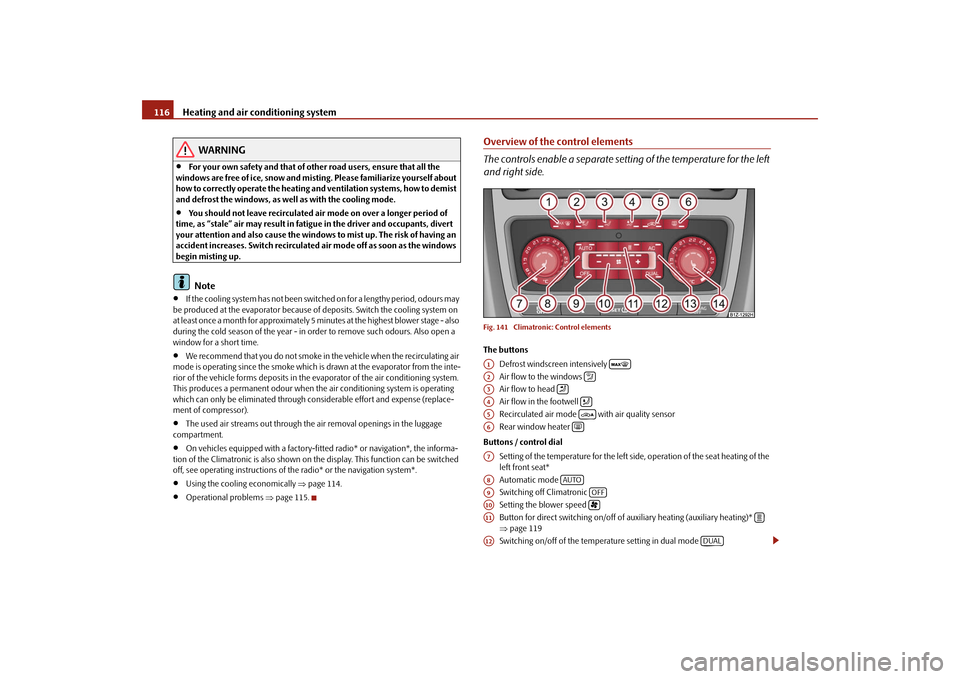
Heating and air conditioning system
116
WARNING
•
For your own safety and that of other road users, ensure that all the
windows are free of ice, snow and mistin
g. Please familiarize yourself about
how to correctly operate th
e heating and ventilation systems, how to demist
and defrost the windows, as well as with the cooling mode.•
You should not leave recirculated air mode on over a longer period of
time, as “stale” air may result in fatigue in the driver and occupants, divert your attention and also cause the windows to mist up. The risk of having an accident increases. Switch recirculated air mode off as soon as the windows begin misting up.
Note
•
If the cooling system has not been switched on for a lengthy period, odours may
be produced at the evaporator because of
deposits. Switch the cooling system on
at least once a month for approximately 5 mi
nutes at the highest blower stage - also
during the cold season of the year - in order to remove such odours. Also open a window for a short time.•
We recommend that you do not smoke in the vehicle when the recirculating air
mode is operating since the smoke which is drawn at the evaporator from the inte-rior of the vehicle forms deposits in the
evaporator of the air
conditioning system.
This produces a permanent odour when the air conditioning system is operating which can only be eliminated through considerable effort and expense (replace-ment of compressor).•
The used air streams out through the air removal openings in the luggage
compartment.•
On vehicles equipped with a factory-fitted radio* or navigation*, the informa-
tion of the Climatronic is also shown on th
e display. This function can be switched
off, see operating instructions of th
e radio* or the navigation system*.
•
Using the cooling economically
⇒page 114.
•
Operational problems
⇒page 115.
Overview of the control elements The controls enable a separate setting of the temperature for the left and right side.Fig. 141 Climatronic: Control elementsThe buttons
Defrost windscreen intensively Air flow to the windows Air flow to head Air flow in the footwell Recirculated air mode with air quality sensor Rear window heater
Buttons / control dial
Setting of the temperature for the left side, operation of the seat heating of the left front seat* Automatic mode Switching off Climatronic Setting the blower speed Button for direct switching on/off of auxiliary heating (auxiliary heating)* ⇒ page 119 Switching on/off of the temperature setting in dual mode
A1
A2
A3
A4
A5
A6
A7A8
AUTO
A9
OFF
A10
A11
A12
DUAL
se0.1.book Page 116 Frida
y, April 10, 2009 3:19 PM
Page 118 of 304

Heating and air conditioning system
117
Using the system
Safety
Driving Tips
General Maintenance
Breakdown assistance
Technical Data
Switching cooling on and off Setting of the temperature for the right side, operation of the seat heating of the right front seat*Note
Below the top row of buttons is located the interior temperature sensor. Do not glue or cover over the sensor, otherwise it could have an unfavourable effect on the Climatronic.Automatic mode The automatic mode is used in orde
r to maintain a constant temper-
ature and to demist the windows in the interior of the car.Switching automatic mode on – Set a temperature between +18 °C and +26 °C. – Move the air outlet vents
3 and
4 ⇒
page 108, fig. 137
, so that the air
flow is directed slightly upwards.
– Press the button . In the right or left top corner a warning light
lights up, depending on which unit was last selected.
If the warning light in the top right corner of the button lights up, the Climatronic operates in “HIGH” mode. The “HIGH” mode is the standard setting of the Climatronic. When pressing again the button , the Climatronic changes into the “LOW” mode and the warning light in the top left
corner lights up. The Climatronic uses
only in this mode the lower blower speed.
However taking into
account the noise
level, this is more comfortable, yet be aw
are that the effectiveness of the air condi-
tioning system is reduced particularly
if the vehicle is fully occupied.
By pressing again the button , yo
u change into the “HIGH” mode.
The automatic mode is switched off by pr
essing the button for the air distribution
or increasing or decreasing the blower speed. The temperature is nevertheless regulated.
switching cooling on and offswitching cooling on and off – Press the button
⇒
page 116, fig. 141
. The warning light lights up
in the button.
– When you again press the switch , the cooling system is switched
off. The warning light in the button
goes out. Only the function of the
ventilation remains active when
no lower temperature than the
outside temperature can be reached.
Setting temperatureYou can separate the interior temperature for the left and right side sepa-rately. – You can set the temperature for both sides after switching on the igni-
tion with the control dial .
– If you wish to set the temperature for the right side, turn the control
dial . The warning light in the bu
tton lights up, this indicates
that differing temperatures for the left and right side can be set.
If the warning light in the button lights up, the temperature for both sides cannot be set with the control dial . You
can reinitiate this function by pressing
the button . The warning light in the bu
tton which indicates the possibility to
set differing temperatures for the left and right side, goes out. You can set the interior temperature be
tween +18°C and +26°C. The interior
temperature is regulated automatically within this range. If you chose a tempera- ture lower than +18°C, a blue symbol lights
up at the start of the numerical scale. If
you chose a temperature higher than +26°C,
a red symbol lights up at the end of
the numerical scale. In both limit positi
ons the Climatronic operates at maximum
cooling or heating capacity, respectively.
The temperature is not controlled in this
case.
A13
AC
A14
AUTO
AUTO
AUTO
AUTO
AC
AC
A7
A14
DUAL
DUALA7
DUAL
se0.1.book Page 117 Frida
y, April 10, 2009 3:19 PM
Page 119 of 304

Heating and air conditioning system
118
Lengthy and uneven distribution of the air flow out of the vents (in particular at the leg area) and large differences in temperature, for example when getting out of the vehicle, can result in chills in sensitive persons.Recirculated air mode In recirculated air mode air is sucked
out of the interior of the vehicle
and then fed back into the interior. When the automatic air distribu-tion control is switched on, an air quality sensor measures the concentration of pollutants in the drawn-in air.Recirculated air mode prevents polluted air outside the vehicle from getting into the vehicle, for example when driving through a tunnel or when standing in a traffic jam. If a considerable increase in concentration of pollutants is recognized by the ai
r quality sensor, when the automatic
air distribution control is switched
on, the air distribution control will
temporarily be switched off. If the concentration of pollutants decreases to the normal level, the air distributi
on control is automatically switched
off so that fresh air can be guided into the vehicle interior. Switching recirculated air mode on – Press the button repeatedly until the warning light on the left
side of the button lights up.
Switch on automatic air distribution control – Press the button repeatedly until the warning light on the right
side of the button lights up.
Switch off automatic air distribution control temporarily – If the air quality sensor does not sw
itch on the air distribution control
automatically when there is a nausea
ting smell, you can switch it on
yourself by pressing the button *.
The warning light lights up in
the button on the left side.
Switching recirculated air mode off – Press the button or press the button repetitively, until the
warning lights in the button go out.
WARNING
You should not leave recirculated air mode on over a longer period of time, as “stale” air may result in fatigue in the driver and occupants, divert your attention and also cause the windows to mist up. The risk of having an acci- dent increases. Switch recirculated air mode off as soon as the windows begin misting up.
Note
•
If the windscreen mists up, press the button
⇒page 116, fig. 141
.
After the windscreen has been demisted, press the button .•
The automatic air distribution control operates only if the outside temperature
is higher than approx. 2°C.Controlling blower There are a total of seven blower stages available.The Climatronic system controls the bl
ower stages automatically in line
with the interior temperature. You
can also, however, adapt the blower
stages manually to suit your particular needs. – Press again the button on the left side (reduce blower speed) or on
the right side (increase blower speed).
If you switch off the blower, th
e Climatronic is switched off.
The set blower speed is displayed above the button when the respective number of warning lights come on.
AUTO
A1
AUTO
se0.1.book Page 118 Frida
y, April 10, 2009 3:19 PM
Page 120 of 304
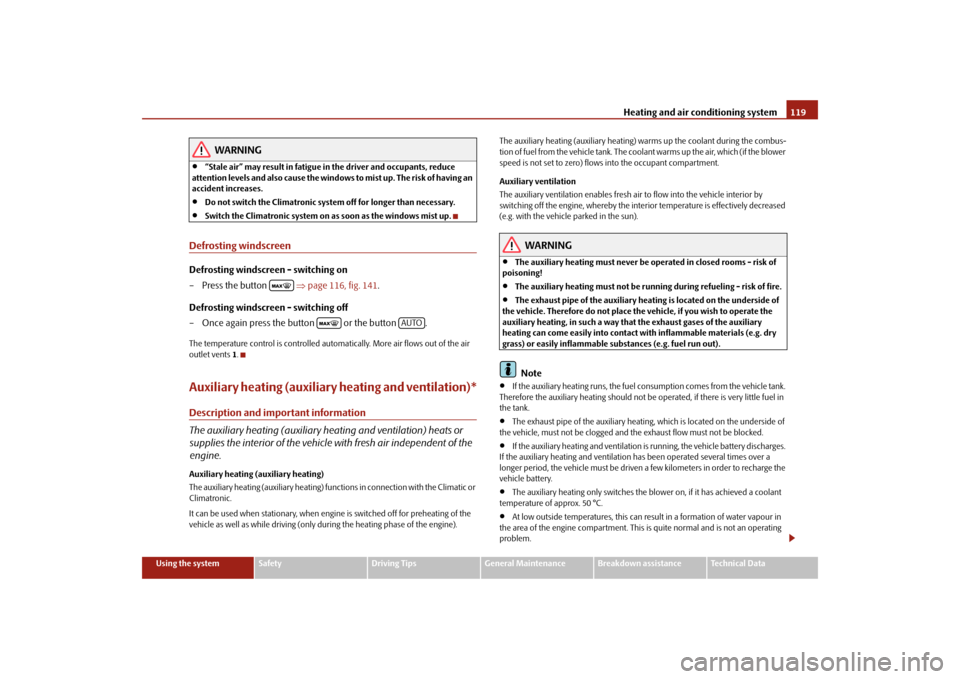
Heating and air conditioning system
119
Using the system
Safety
Driving Tips
General Maintenance
Breakdown assistance
Technical Data
WARNING
•
“Stale air” may result in fatigue in the driver and occupants, reduce
attention levels and also cause the windows to mist up. The risk of having an accident increases.•
Do not switch the Climatronic system off for longer than necessary.
•
Switch the Climatronic system on as soon as the windows mist up.
Defrosting windscreenDefrosting windscreen - switching on – Press the button
⇒
page 116, fig. 141
.
Defrosting windscreen - switching off – Once again press the button or the button .The temperature control is controlled automa
tically. More air flows out of the air
outlet vents
1.
Auxiliary heating (auxiliary heating and ventilation)*Description and important information The auxiliary heating (auxiliary heating and ventilation) heats or supplies the interior of the vehicl
e with fresh air independent of the
engine.Auxiliary heating (auxiliary heating) The auxiliary heating (auxiliary heating) f
unctions in connection with the Climatic or
Climatronic. It can be used when stationa
ry, when engine is switched off for preheating of the
vehicle as well as while driving (only during the heating phase of the engine).
The auxiliary heating (auxiliary heating)
warms up the coolant during the combus-
tion of fuel from the vehicle tank. The coolant warms up the air, which (if the blower speed is not set to zero) flows into the occupant compartment. Auxiliary ventilation The auxiliary ventilation enables fresh air to flow into the vehicle interior by switching off the engine, whereby the interior temperature is effectively decreased (e.g. with the vehicle parked in the sun).
WARNING
•
The auxiliary heating must never be operated in closed rooms - risk of
poisoning!•
The auxiliary heating must not be running during refueling - risk of fire.
•
The exhaust pipe of the auxiliary heating is located on the underside of
the vehicle. Therefore do not place the
vehicle, if you wish to operate the
auxiliary heating, in su
ch a way that the exhaust gases of the auxiliary
heating can come easily into contact
with inflammable materials (e.g. dry
grass) or easily inflammable su
bstances (e.g. fuel run out).
Note
•
If the auxiliary heating runs, the fuel
consumption comes from the vehicle tank.
Therefore the auxiliary heating should not be operated, if there is very little fuel in the tank.•
The exhaust pipe of the auxiliary heating,
which is located on the underside of
the vehicle, must not be clogged and
the exhaust flow must not be blocked.
•
If the auxiliary heating and
ventilation is runni
ng, the vehicle battery discharges.
If the auxiliary heating and ventilation
has been operated several times over a
longer period, the vehicle must be driven a few kilometers in order to recharge the vehicle battery.•
The auxiliary heating only switches the bl
ower on, if it has achieved a coolant
temperature of approx. 50 °C.•
At low outside temperatures, this can result in a formation of water vapour in
the area of the engine compartment. This is quite normal and is not an operating problem.
AUTO
se0.1.book Page 119 Frida
y, April 10, 2009 3:19 PM